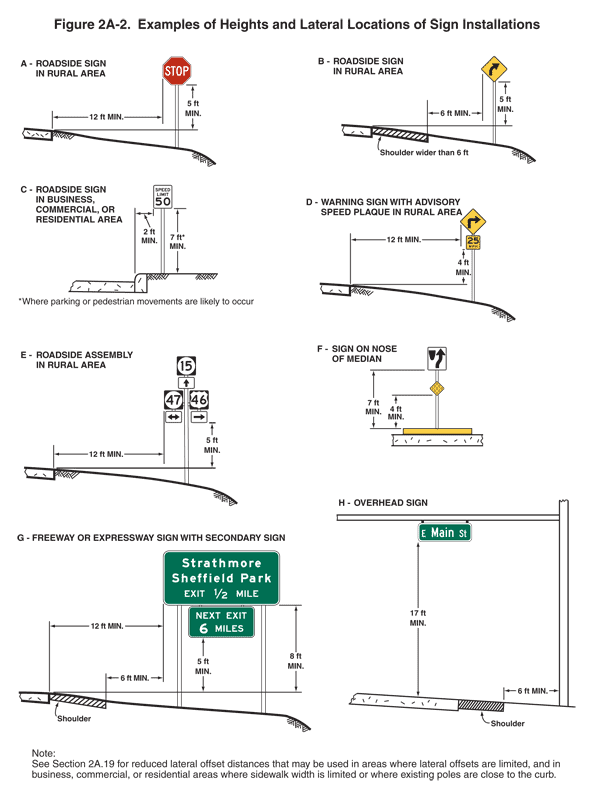|
|
2009 Edition Part 2 Figure 2A-2. Examples of Heights and Lateral Locations of Sign Installations

Figure 2A-2. Examples of Heights and Lateral Locations of Sign Installations
This figure shows eight examples of heights and lateral locations of sign installations, labeled A through H.
A is labeled "Roadside Sign in Rural Area." The roadway is shown with no shoulder. The sign in this example is a STOP sign. The distance from the bottom edge of the sign to the level of the edge of the pavement is shown as a dimension of 5 ft MIN. The distance between the edge of the pavement and the near edge of the sign is shown as a dimension of 12 ft MIN.
B is labeled "Roadside Sign in Rural Area." The road is shown with a shoulder wider than 6 ft. The sign in this example is a Curve Warning sign. The distance from the bottom edge of the sign to the level of the edge of the travel lane at the inside edge of the shoulder is shown as a dimension of 5 ft MIN. The distance between the outside edge of the shoulder and the near edge of the sign is shown as a dimension of 6 ft MIN.
C is labeled "Roadside Sign in Business, Commercial, or Residential Area." The road is shown with a curb along the outside edge of the pavement. The sign in this example is a Speed Limit sign. The distance from the bottom edge of the sign to the surface of the sidewalk is shown as a dimension of 7 ft MIN. A note for this dimension states "Where parking or pedestrian movements are likely to occur." The distance from the edge of the pavement to the near edge of the sign is shown as a dimension of 2 ft MIN.
D is labeled "Warning Sign With Advisory Speed Plaque in Rural Area." The sign in this example is a Curve Warning sign with a 25 MPH advisory speed plaque mounted below. The distance from the bottom edge of the secondary sign to the surface of the pavement is shown as a dimension of 4 ft MIN. The distance from the pavement edge to the near edge of the Warning sign is shown as a dimension of 12 ft MIN.
E is labeled "Roadside Assembly in Rural Area" and shows the placement of a roadside assembly consisting of several route markers and directional arrow markers. The distance from the bottom edge of the lowest sign to the pavement is shown as a dimension of 5 ft MIN. The distance from the pavement edge to the near edge of the closest sign is shown as a dimension of 12 ft MIN.
F is labeled "Sign on Nose of Median." The sign in this example is a vertical rectangular white sign with a black border and legend mounted above an object marker. At the top left corner of the sign, a depiction of the plan view of the nose of a traffic island is shown. An upward-pointing arrow is shown on the sign, curving to depict movement to the right of the nose of the island. The distance from the bottom edge of the Warning sign to the pavement is shown as a dimension of 7 ft MIN. The distance from the bottom edge of the object marker to the pavement is shown as a dimension of 4 ft MIN.
G is labeled "Freeway or Expressway Sign With Secondary Sign" and shows the placement of a roadside assembly consisting of an Interchange Advance Guide sign mounted above a Next Exit supplemental sign. The roadway is shown with a shoulder. The distance between the edge of the roadway and the near edge of the sign is shown as a dimension of 12 ft MIN, and the distance between the outside edge of the shoulder and the near edge of the sign is shown as a dimension of 6 ft MIN. The distance from the bottom edge of the supplemental sign is shown as a dimension of 5 ft MIN, and the distance from the bottom edge of the Interchange Advance Guide sign is shown as a dimension of 8 ft MIN.
H is labeled "Overhead Sign" and shows an overhead mounting of a Directional Guide sign. The roadway is shown with a shoulder. The distance from the bottom edge of the sign to the pavement and shoulder is shown as a dimension of 17 ft MIN. The distance from the nearest edge of the shoulder to the nearest side of the roadside pole supporting the overhead sign is shown as a dimension of 6 ft MIN.
A note at the bottom of the figure states "See Section2A-19 for reduced lateral offset distances that may be used in areas where lateral offsets are limited, and in business, commercial, or residential areas where sidewalk width is limited or where existing poles are close to the curb."
